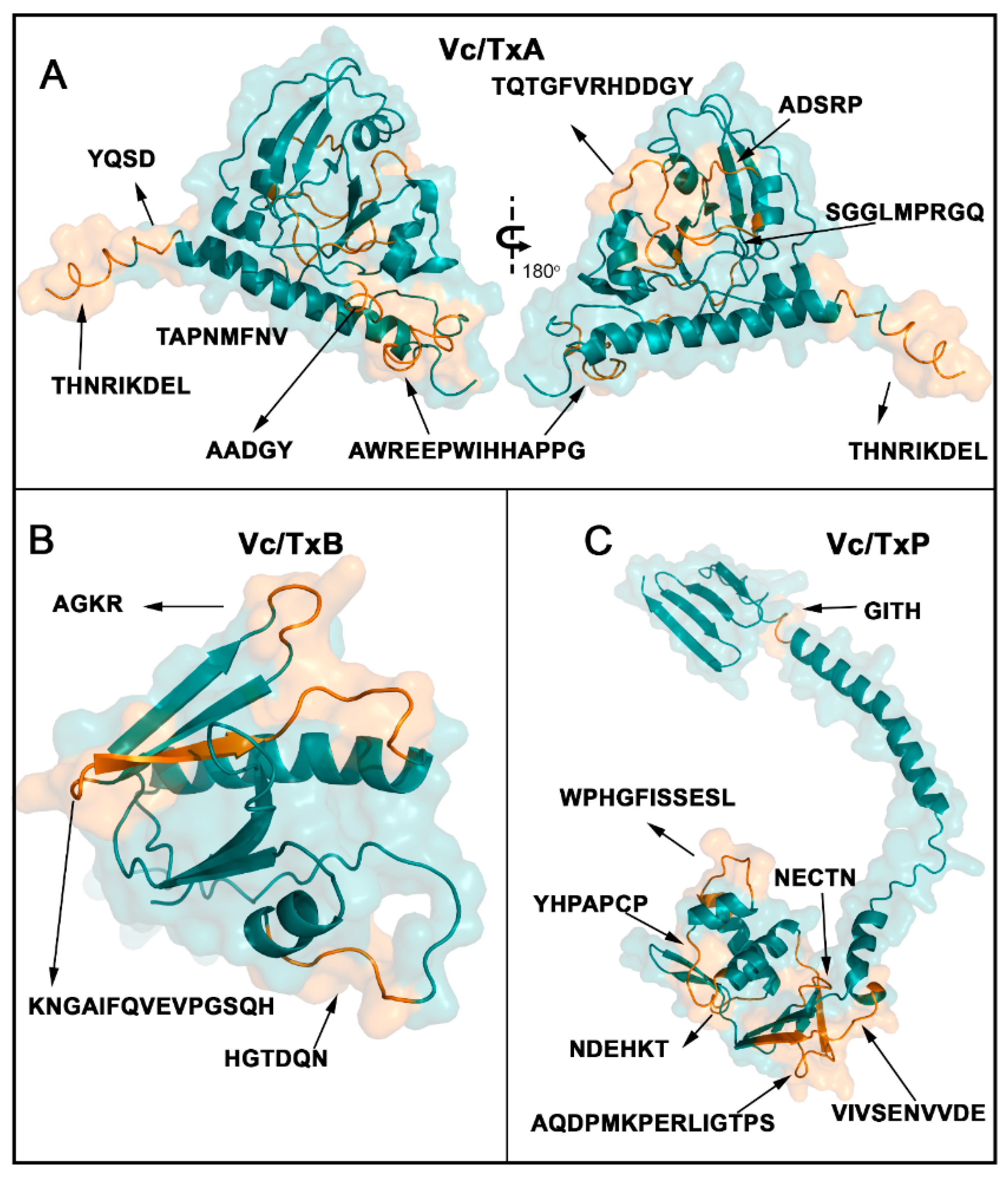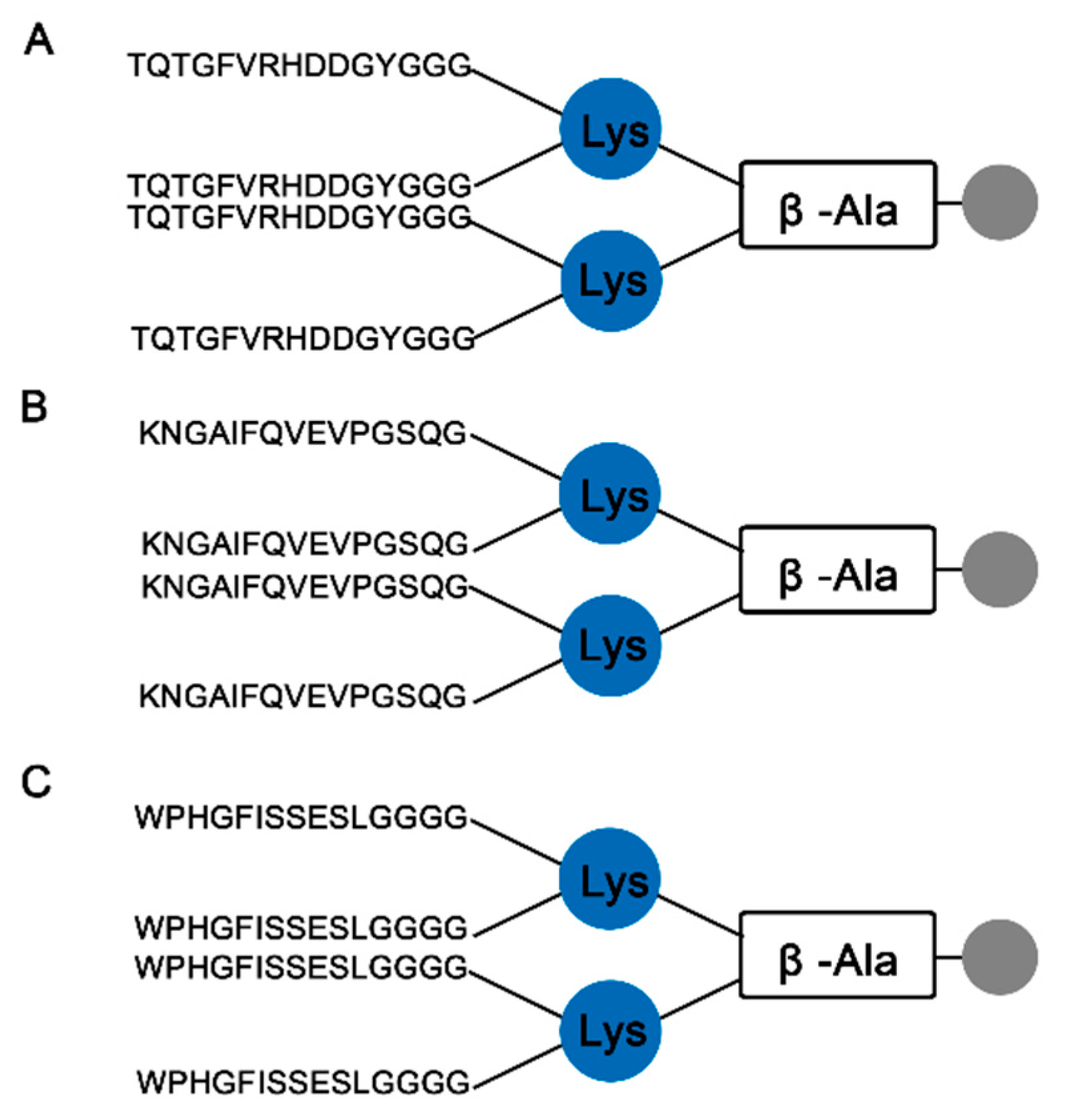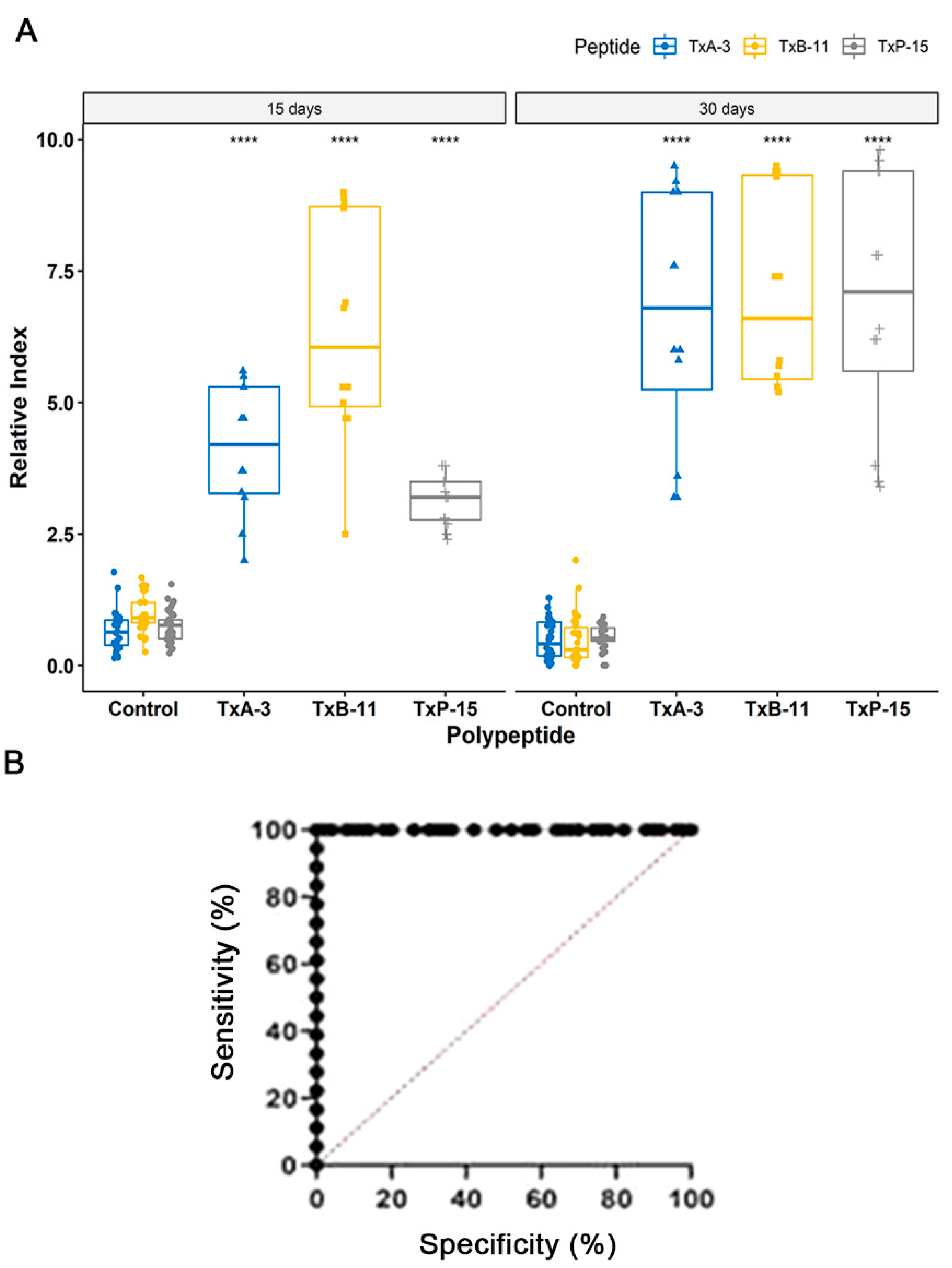B-Cell Epitope Mapping of the Vibrio cholera Toxins A, B, and P and an ELISA Assay
Abstract
1. Introduction
2. Results
2.1. Identification of the Immunodominant IgG Epitopes in Cholera Toxin
2.2. Localization of the Major B Epitopes within the Three Enterotoxins
| Protein Code | aa | Sequence | 2nd Structure * | Code | Peptide Search ** |
|---|---|---|---|---|---|
| P01555 | 26–30 | ADSRP | C | Vc/TxA-1/miG | Various bacteria |
| 37–45 | SGGLMPRGQ | C | Vc/TxA-2/miG | Sp | |
| 66–77 | TQTGFVRHDDGY | C | Vc/TxA-3/miG | Sp | |
| 108–115 | TAPNMFNV | C | Vc/TxA-4/miG | E. coli | |
| 176–180 | AADGY | C | Vc/TxA-5/miG | Various bacteria | |
| 191–204 | AWREEPWIHHAPPG | C | Vc/TxA-6/miG | Sp | |
| 244–245 | YQSD | C | Vc/TxA-7/miG | Various bacteria | |
| 250–258 | THNRIKDEL | C | Vc/TxA-8/miG | Sp | |
| P01556 | 20–25 | HGTDQN | C | Vc/TxB-9/miG | Sp |
| 53–56 | AGKR | C | Vc/TxB-10/miG | Sp | |
| 64–77 | KNGAIFQVEVPGSQ | C + S + C | Vc/TxB-11/miG | Sp | |
| P29485 | 17–21 | NECTN | C | Vc/TxP-12/miG | Various bacteria, virus |
| 26–40 | AQDPMKPERLIGTPS | C + S + C | Vc/TxP-13/miG | Sp | |
| 53–59 | YHPAPCP | C | Vc/TxP-14/miG | Sp | |
| 68–77 | WPHGFISSESL | C + H | Vc/TxP-15/miG | Sp | |
| 90–95 | NDEHKT | C | Vc/TxP-16/miG | Sp | |
| 112–121 | VIVSENVVDE | S + C | Vc/TxP-17/miG | Sp | |
| 174–177 | GITH | C | Vc/TxP-18/miG | Various bacteria |
2.3. Spatial Location of the Reactive Epitopes of Enterotoxin A, B, and P
2.4. Specific and Cross-Immune IgG Epitopes
2.5. Epitope Reactivity by ELISA
3. Discussion
4. Materials and Methods
4.1. Immunization of Mice
4.2. Synthesis of the Cellulose Membrane-Bound Peptide Array
4.3. Screening of SPOT Membranes
4.4. Scanning and Measurement of Spot Signal Intensities
4.5. Preparation of the Multi-Antigen Peptides
4.6. ELISA
4.7. Structural Localization of the IgG Epitopes and Bioinformatics Tools
4.8. Statistical Analysis
5. Conclusions
Supplementary Materials
Author Contributions
Funding
Institutional Review Board Statement
Informed Consent Statement
Data Availability Statement
Acknowledgments
Conflicts of Interest
References
- Ali, M.; Nelson, A.R.; Lopez, A.L.; Sack, D.A. Updated global burden of cholera in endemic countries. PLoS Negl. Trop. Dis. 2015, 9, e0003832. [Google Scholar] [CrossRef] [PubMed]
- Yuki, Y.; Nojima, M.; Hosono, O.; Tanaka, H.; Kimura, Y.; Satoh, T.; Imoto, S.; Uematsu, S.; Kurokawa, S.; Kashima, K.; et al. Oral MucoRice-CTB vaccine for safety and microbiota-dependent immunogenicity in humans: A phase 1 randomized trial. Lancet Microbe 2021, 2, e429–e440. [Google Scholar] [CrossRef] [PubMed]
- Vezzulli, L.; Grande, C.; Reid, P.C.; Hélaouët, P.; Edwards, M.; Höfle, M.G.; Brettar, I.; Colwell, R.R.; Pruzzo, C. Climate influence on Vibrio and associated human diseases during the past half-century in the coastal North Atlantic. Proc. Natl. Acad. Sci. USA 2016, 113, E5062–E5071. [Google Scholar] [CrossRef] [PubMed]
- Deeb, R.; Tufford, D.; Scott, G.I.; Moore, J.G.; Dow, K. Impact of climate change on Vibrio vulnificus abundance and exposure risk. Estuaries Coasts 2018, 41, 2289–2303. [Google Scholar] [CrossRef] [PubMed]
- Baker-Austin, C.; Oliver, J.D.; Alam, M.; Ali, A.; Waldor, M.K.; Qadri, F.; Martinez-Urtaza, J.; Martinez-Urtaza, J. Vibrio spp. Infections. Nat. Rev. Dis. Prim. 2018, 4, 1–19. [Google Scholar] [CrossRef]
- Legros, D.; Partners of the Global Task Force on Cholera Control. Global cholera epidemiology: Opportunities to reduce the burden of cholera by 2030. J. Infect. Dis. 2018, 218, S137–S140, Erratum in J. Infect. Dis. 2019, 219, 509. [Google Scholar] [CrossRef]
- WHO. Cholera; World Health Organization: Geneva, Switzerland, 2022. [Google Scholar]
- Banerjee, T.; Grabon, A.; Taylor, M.; Teter, K. cAMP-Independent activation of the unfolded protein response by cholera toxin. Infect. Immun. 2021, 89, e00447-e20. [Google Scholar] [CrossRef]
- Clemens, J.D.; Nair, G.B.; Ahmed, T.; Qadri, F.; Holmgren, J. Cholera. Lancet 2017, 390, 1539–1549. [Google Scholar] [CrossRef]
- Bourque, D.L.; Bhuiyan, T.R.; Genereux, D.P.; Rashu, R.; Ellis, C.N.; Chowdhury, F.; Khan, A.I.; Alam, N.H.; Paul, A.; Hossain, L.; et al. Analysis of the human mucosal response to cholera reveals sustained activation of innate immune signaling pathways. Infect. Immun. 2018, 86, e00594-17. [Google Scholar] [CrossRef]
- Sánchez, J.; Holmgren, J. Cholera toxin-a foe & a friend. Indian J. Med. Res. 2011, 133, 153. [Google Scholar]
- Taylor, R.K.; Miller, V.L.; Furlong, D.B.; Mekalanos, J.J. Use of phoA gene fusions to identify a pilus colonization factor coordinately regulated with cholera toxin. Proc. Natl. Acad. Sci. USA 1987, 84, 2833–2837. [Google Scholar] [CrossRef] [PubMed]
- Waldor, M.K.; Colwell, R.; Mekalanos, J.J. The Vibrio cholerae O139 serogroup antigen includes an O-antigen capsule and lipopolysaccharide virulence determinants. Proc. Natl. Acad. Sci. USA 1994, 91, 11388–11392. [Google Scholar] [CrossRef] [PubMed]
- Sperandio, V.; Giron, J.A.; Silveira, W.D.; Kaper, J.B. The OmpU outer membrane protein, a potential adherence factor of Vibrio cholerae. Infect. Immun. 1995, 63, 4433–4438. [Google Scholar] [CrossRef] [PubMed]
- Sengupta, D.K.; Sengupta, T.K.; Ghose, A.C. Major outer membrane proteins of Vibrio cholerae and their role in induction of protective immunity through inhibition of intestinal colonization. Infect. Immun. 1992, 60, 4848–4855. [Google Scholar] [CrossRef] [PubMed]
- Nandi, B.; Nandy, R.K.; Sarkar, A.; Ghose, A.C. Structural features, properties and regulation of the outer-membrane protein W (OmpW) of Vibrio cholerae. Microbiology 2005, 151, 2975–2986. [Google Scholar] [CrossRef]
- Qadri, F.; Ali, M.; Chowdhury, F.; Khan, A.I.; Saha, A.; Khan, I.A.; Begum, Y.A.; Bhuiyan, T.R.; Chowdhury, M.I.; Uddin, M.J.; et al. Feasibility and effectiveness of oral cholera vaccine in an urban endemic setting in Bangladesh: A cluster randomized open-label trial. Lancet 2015, 386, 1362–1371. [Google Scholar] [CrossRef] [PubMed]
- Bi, Q.; Ferreras, E.; Pezzoli, L.; Legros, D.; Ivers, L.C.; Date, K.; Qadri, F.; Digilio, L.; Sack, D.A.; Ali, M.; et al. Protection against cholera from killed whole-cell oral cholera vaccines: A systematic review and meta-analysis. Oral cholera vaccine working group of the global task force on cholera control. Lancet Infect. Dis. 2017, 17, 1080–1088. [Google Scholar] [CrossRef] [PubMed]
- Peak, C.M.; Reilly, A.L.; Azman, A.S.; Buckee, C.O. Prolonging herd immunity to cholera via vaccination: Accounting for human mobility and waning vaccine effects. PLoS Negl. Trop. Dis. 2018, 12, e0006257. [Google Scholar] [CrossRef]
- Royal, J.M.; Reeves, M.A.; Matoba, N. Repeated oral administration of a KDEL-tagged recombinant cholera toxin B subunit effectively mitigates DSS colitis despite a robust immunogenic response. Toxins 2019, 11, 678. [Google Scholar] [CrossRef]
- Kabir, S. Critical analysis of compositions and protective efficacies of oral killed cholera vaccines. Clin. Vaccine Immunol. 2014, 21, 1195–1205. [Google Scholar] [CrossRef]
- Chen, W.H.; Cohen, M.B.; Kirkpatrick, B.D.; Brady, R.C.; Galloway, D.; Gurwith, M.; Hall, R.H.; Kessler, R.A.; Lock, M.; Haney, D.; et al. Single-dose live oral cholera vaccine CVD 103-HgR protects against human experimental infection with Vibrio cholerae El Tor. Clin. Infect. Dis. 2016, 62, 1329–1335. [Google Scholar] [CrossRef] [PubMed]
- Holmgren, J.J. Modern history of cholera vaccines and the pivotal role of ICDDR. Infect. Dis. 2021, 224, S742–S748. [Google Scholar] [CrossRef] [PubMed]
- Wierzba, T.F. Oral cholera vaccines and their impact on the global burden of disease. Hum. Vaccines Immunother. 2019, 15, 1294–1301. [Google Scholar] [CrossRef]
- Qadri, F.; Chowdhury, M.I.; Faruque, S.M.; Salam, M.A.; Ahmed, T.; Begum, Y.A.; Saha, A.; Al Tarique, A.; Seidlein, L.V.; Park, E.; et al. PXV Study Group, Peru-15, a live attenuated oral cholera vaccine, is safe and immunogenic in Bangladeshi toddlers and infants. Vaccine 2007, 25, 231–238. [Google Scholar] [CrossRef] [PubMed]
- Calain, P.; Chaine, J.P.; Johnson, E.; Hawley, M.L.; O’Leary, M.J.; Oshitani, H.; Chaignat, C.L. Can oral cholera vaccination play a role in controlling a cholera outbreak? Vaccine 2004, 22, 2444–2451. [Google Scholar] [CrossRef] [PubMed]
- Song, K.R.; Lim, J.K.; Park, S.E.; Saluja, T.; Cho, S.I.; Wartel, T.A.; Lynch, J. Oral cholera vaccine efficacy and effectiveness. Vaccines 2021, 9, 1482. [Google Scholar] [CrossRef]
- Khatib, A.M.; Ali, M.; von Seidlein, L.; Kim, D.R.; Hashim, R.; Reyburn, R.; Ley, B.; Thriemer, K.; Enwere, G.; Hutubessy, R.; et al. Effectiveness of an oral cholera vaccine in Zanzibar: Findings from a mass vaccination campaign and observational cohort study. Lancet Infect. Dis. 2012, 1, 837–844. [Google Scholar] [CrossRef]
- Kanungo, S.; Azman, A.S.; Ramamurthy, T.; Deen, J.; Dutta, S. Cholera. Lancet 2022, 399, 1429–1440. [Google Scholar] [CrossRef]
- Ali, M.; Sur, D.; You, Y.A.; Kanungo, S.; Sah, B.; Manna, B.; Puri, M.; Wierzba, T.F.; Donner, A.; Nair, G.B.; et al. Herd protection by a bivalent killed whole-cell oral cholera vaccine in the slums of Kolkata, India. Clin. Infect. Dis. 2013, 56, 1123–1131. [Google Scholar] [CrossRef]
- De Groot, A.S.; Moise, L.; McMurry, J.A.; Martin, W. Epitope-based immunome-derived vaccines: A strategy for improved design and safety. In Clinical Applications of Immunomics; Springer: Heidelberg, Germany, 2009; pp. 39–69. [Google Scholar]
- Winkler, D.F.H. SPOT Synthesis: The solid-phase peptide synthesis on planar surfaces. Methods Mol. Biol. 2020, 2103, 151–173. [Google Scholar]
- Pastor, M.; Pedraz, J.; Esquisabel, A. The state-of-the-art of approved and under-development cholera vaccines. Vaccine 2013, 31, 4069–4078. [Google Scholar] [CrossRef] [PubMed]
- Chiappelli, F.; Khakshooy, A.; Balenton, N. Clinical immunology of Cholera—Current trends and directions for future advancement. Bioinformation 2017, 13, 352–355. [Google Scholar] [CrossRef] [PubMed]
- Holmgren, J. An update on cholera immunity and current and future cholera vaccines. Trop. Med. Infect. Dis. 2021, 6, 64. [Google Scholar] [CrossRef]
- Shaikh, H.; Lynch, J.; Kim, J.; Excler, J.L. Current and future cholera vaccines. Vaccine 2020, 38, A118–A126. [Google Scholar] [CrossRef]
- Pinkhasov, J.; Alvarez, M.L.; Pathangey, L.B.; Tinder, T.L.; Mason, H.S.; Walmsley, A.M.; Gendler, S.J.; Mukherjee, P. Analysis of a cholera toxin B subunit (CTB) and human mucin 1 (MUC1) conjugate protein in a MUC1-tolerant mouse model. Cancer Immunol. Immunother. 2010, 59, 1801–1811. [Google Scholar] [CrossRef] [PubMed]
- Mekalanos, J.; Collier, R.; Romig, W. Enzymic activity of cholera toxin. II. Relationships to proteolytic processing, disulfide bond reduction, and subunit composition. J. Biol. Chem. 1979, 254, 5855–5861. [Google Scholar] [CrossRef] [PubMed]
- Sánchez, J.; Holmgren, J. Cholera toxin structure, gene regulation, and pathophysiological and immunological aspects. Cell. Mol. Life Sci. 2008, 65, 1347–1360. [Google Scholar] [CrossRef] [PubMed]
- Bharati, K.; Ganguly, N.K. Cholera toxin: A paradigm of a multifunctional protein. Indian J. Med. Res. 2011, 133, 179. [Google Scholar]
- Sikora, A.E. Proteins secreted via the type II secretion system: Smart strategies of Vibrio cholerae to maintain fitness in different ecological niches. PLoS Pathog. 2013, 9, e1003126. [Google Scholar] [CrossRef]
- Mayo, S.; Royo, F.; Hau, J. Correlation between adjuvanticity and immunogenicity of cholera toxin B subunit in orally immunized young chickens. APMIS 2005, 113, 284–287. [Google Scholar] [CrossRef]
- Kim, M.S.; Yi, E.J.; Kim, Y.I.; Kim, S.H.; Jung, Y.S.; Kim, S.R.; Iwawaki, T.; Ko, H.J.; Chang, S.Y. ERdj5 in innate immune cells is a crucial factor for the mucosal adjuvanticity of cholera toxin. Front. Immunol. 2019, 10, 1249. [Google Scholar] [CrossRef] [PubMed]
- Hou, J.; Liu, Y.; Tao, R.; Hsi, J.; Shao, Y.; Wang, H. Cholera Toxin B subunit acts as a potent systemic adjuvant for HIV-1 DNA vaccination intramuscularly in mice. Hum. Vaccines Immunother. 2014, 10, 1274–1283. [Google Scholar] [CrossRef] [PubMed]
- Price, G.A.; Holmes, R.K. Evaluation of TcpF-A2-CTB chimera and evidence of additive protective efficacy of immunizing with TcpF and CTB in the suckling mouse model of cholera. PLoS ONE 2012, 7, e42434. [Google Scholar] [CrossRef] [PubMed]
- Zareitaher, T.; Sadat, T.; Seyed, A.S.; Gargari, L.M. Immunogenic efficacy of DNA and protein-based vaccine from a chimeric gene consisting OmpW, TcpA and CtxB, of Vibrio cholerae. Immunobiology 2022, 227, 152190. [Google Scholar] [CrossRef]
- Jacob, C.O.; Harari, I.; Arnon, R.; Sela, M. Antibodies to cholera toxin synthetic peptides of increasing size and their reactivity with related toxins. Vaccine 1986, 4, 95–98. [Google Scholar] [CrossRef]
- Jacob, C.O.; Sela, M.; Arnon, R. Antibodies against synthetic peptides of the B subunit of cholera toxin: Cross-reaction and neutralization of the toxin. Proc. Natl. Acad. Sci. USA 1983, 80, 7611–7615. [Google Scholar] [CrossRef]
- Sela, M.; Arnon, R.; Jacob, C.O. Synthetic peptides with antigenic specificity for bacterial toxins. In Ciba Foundation Symposium 119-Synthetic Peptides as Antigens: Synthetic Peptides as Antigens; John Wiley & Sons, Ltd.: Chichester, UK, 1986; Volume 119, pp. 184–199. [Google Scholar] [CrossRef]
- Provenzano, D.; Kovác, P.; Wade, W.F. The ABCS (antibody, B cells, and carbohydrate epitopes) of cholera immunity: Considerations for an improved vaccine. Microbiol. Immunol. 2006, 50, 899–927. [Google Scholar] [CrossRef]
- Ali, M.; Lopez, A.L.; You, Y.A.; Kim, Y.E.; Sah, B.; Maskery, B.; Clemens, J. The global burden of cholera. Bull. WHO 2012, 90, 209–218. [Google Scholar] [CrossRef]
- Jeon, S.; Kelly, M.; Yun, J.; Lee, B.; Park, M.; Whang, Y.; Lee, C.; Halvorsen, Y.D.; Verma, S.; Charles, R.C.; et al. Scalable production and immunogenicity of a cholera conjugate vaccine. Vaccine 2021, 39, 6936–6946. [Google Scholar] [CrossRef]
- Leung, D.T.; Chowdhury, F.C.; Calderwood, S.B.; Qadri, F.; Ryan, E.T. Immune responses to cholera in children. Expert Rev. Anti-Infect. Ther. 2012, 4, 435–444. [Google Scholar] [CrossRef]
- Glenny, A.T.; Hopkins, B.E. Diphtheria toxoid as an immunizing agent. Br. J. Exp. Pathol. 1923, 4, 283. [Google Scholar]
- Napoleão-Pêgo, P.; Carneiro, F.R.G.; Durans, A.M.; Gomes, L.R.; Morel, C.M.; Provance, D.W., Jr.; De-Simone, S.G. Performance assessment of multi-epitope chimeric antigen for serodiagnosis of acute phase of Mayaro fever. Sci. Rep. 2021, 11, 15374. [Google Scholar] [CrossRef]
- Colli, A.; Fraquelli, M.; Casazza, G.; Conte, D.; Nikolova, D.; Duca, P.; Thorlund, K.; Gluud, C. The Architecture of diagnostic research: From bench to bedside-research guidelines using liver stiffness as an example. Hepatology 2014, 60, 408–418. [Google Scholar] [CrossRef]
- De Simone, S.G.; Pêgo, P.N.; De-Simone, T.S. Spot synthesis: A healthy and sensitive peptide microarray assay to detect IgE antibodies. In Peptide Microarrays: Methods and Protocols, 2nd ed.; Cretich, M., Chiari, M., Eds.; Methods in Molecular Biology; Human Press: New York, NY, USA, 2016; Volume 1352, pp. 263–277. [Google Scholar]
- De-Simone, S.G.; Gomes, L.R.; Napoleão-Pêgo, P.; Lechuga, G.C.; Pina, J.C.; Silva, F.R. Identification of linear B epitopes liable for the protective immunity of diphtheria toxin. Vaccines 2021, 9, 313. [Google Scholar] [CrossRef]
- Silva, F.R.; Napoleão-Pêgo, P.; De-Simone, S.G. Identification of linear B epitopes of pertactin of Bordetella pertussis induced by immunization with whole and acellular vaccine. Vaccine 2014, 32, 6251–6258. [Google Scholar] [CrossRef]
- De-Simone, S.; Souza, A.L.A.; Melgarejo, A.R.; Aguiar, A.S.; Provance, D.W., Jr. Development of elisa assay to detect specific human IgE anti-therapeutic horse sera. Toxicon 2017, 138, 37–42. [Google Scholar] [CrossRef] [PubMed]
- Roy, A.; Kucukural, A.; Zhang, Y. I-TASSER: A unified platform for automated protein structure and function prediction. Nat. Protoc. 2010, 5, 725–738. [Google Scholar] [CrossRef] [PubMed]
- Jumper, J.; Evansm, R.; Pritzel, A.; Green, T.; Figurnov, M.; Ronneberger, O.; Tunyasuvunakool, K.; Bates, R.; Žídek, A.; Potapenko, A.; et al. Highly accurate protein structure prediction with AlphaFold. Nature 2021, 596, 583–589. [Google Scholar] [CrossRef]




Disclaimer/Publisher’s Note: The statements, opinions and data contained in all publications are solely those of the individual author(s) and contributor(s) and not of MDPI and/or the editor(s). MDPI and/or the editor(s) disclaim responsibility for any injury to people or property resulting from any ideas, methods, instructions or products referred to in the content. |
© 2022 by the authors. Licensee MDPI, Basel, Switzerland. This article is an open access article distributed under the terms and conditions of the Creative Commons Attribution (CC BY) license (https://creativecommons.org/licenses/by/4.0/).
Share and Cite
De-Simone, S.G.; Napoleão-Pêgo, P.; Gonçalves, P.S.; Lechuga, G.C.; Cardoso, S.V.; Provance, D.W., Jr.; Morel, C.M.; da Silva, F.R. B-Cell Epitope Mapping of the Vibrio cholera Toxins A, B, and P and an ELISA Assay. Int. J. Mol. Sci. 2023, 24, 531. https://doi.org/10.3390/ijms24010531
De-Simone SG, Napoleão-Pêgo P, Gonçalves PS, Lechuga GC, Cardoso SV, Provance DW Jr., Morel CM, da Silva FR. B-Cell Epitope Mapping of the Vibrio cholera Toxins A, B, and P and an ELISA Assay. International Journal of Molecular Sciences. 2023; 24(1):531. https://doi.org/10.3390/ijms24010531
Chicago/Turabian StyleDe-Simone, Salvatore G., Paloma Napoleão-Pêgo, Priscilla S. Gonçalves, Guilherme C. Lechuga, Sergian V. Cardoso, David W. Provance, Jr., Carlos M. Morel, and Flavio R. da Silva. 2023. "B-Cell Epitope Mapping of the Vibrio cholera Toxins A, B, and P and an ELISA Assay" International Journal of Molecular Sciences 24, no. 1: 531. https://doi.org/10.3390/ijms24010531
APA StyleDe-Simone, S. G., Napoleão-Pêgo, P., Gonçalves, P. S., Lechuga, G. C., Cardoso, S. V., Provance, D. W., Jr., Morel, C. M., & da Silva, F. R. (2023). B-Cell Epitope Mapping of the Vibrio cholera Toxins A, B, and P and an ELISA Assay. International Journal of Molecular Sciences, 24(1), 531. https://doi.org/10.3390/ijms24010531






